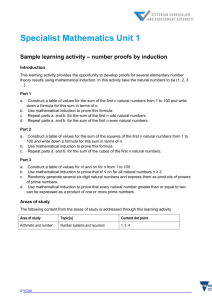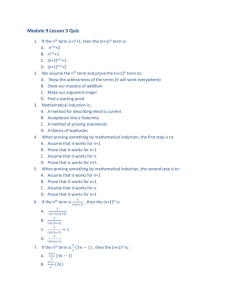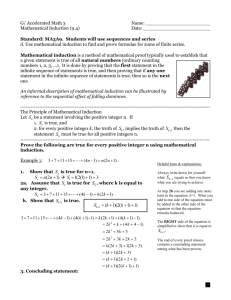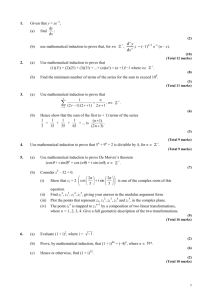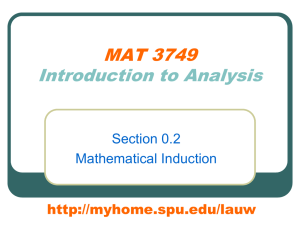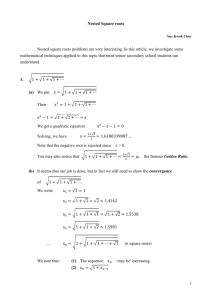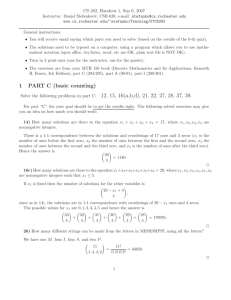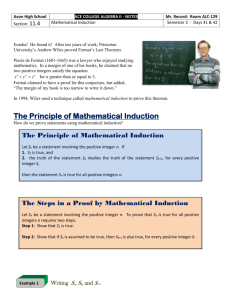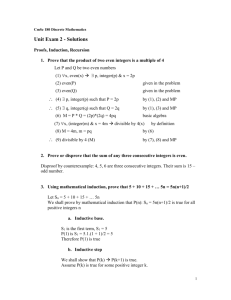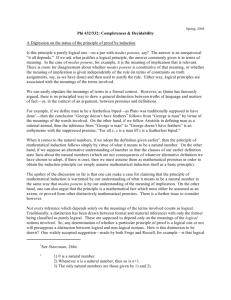Discussions on a Mathematical Induction problem , doc
advertisement
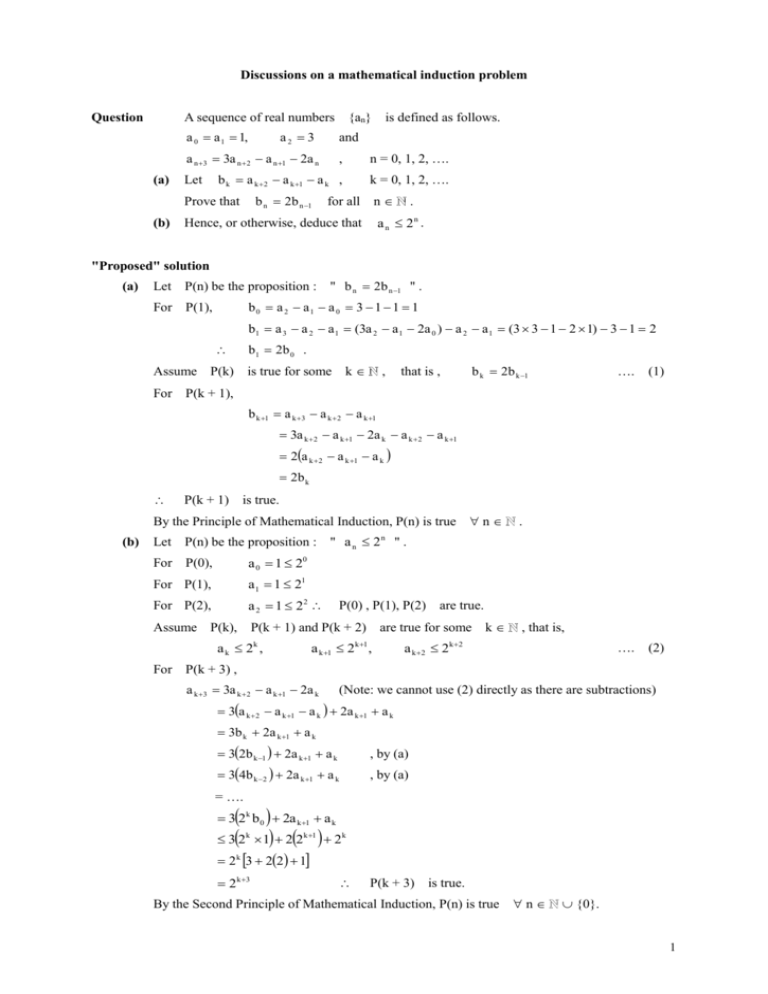
Discussions on a mathematical induction problem
Yue Kwok Choy
Question
A sequence of real numbers {an} is defined as follows.
a 0 a 1 1,
a2 3
and
a n 3 3a n 2 a n 1 2a n
(a)
Let
,
n = 0, 1, 2, ….
b k a k 2 a k 1 a k ,
k = 0, 1, 2, ….
b n 2b n 1
Prove that
(b)
for all n
.
a n 2n .
Hence, or otherwise, deduce that
"Proposed" solution
(a)
Let P(n) be the proposition : " b n 2b n 1 " .
b0 a 2 a1 a 0 3 1 1 1
For P(1),
b1 a 3 a 2 a 1 (3a 2 a 1 2a 0 ) a 2 a 1 (3 3 1 2 1) 3 1 2
b1 2 b 0 .
Assume P(k) is true for some k
,
b k 2b k 1
that is ,
….
(1)
….
(2)
For P(k + 1),
b k 1 a k 3 a k 2 a k 1
3a k 2 a k 1 2a k a k 2 a k 1
2a k 2 a k 1 a k
2b k
P(k + 1) is true.
By the Principle of Mathematical Induction, P(n) is true n
(b)
Let P(n) be the proposition : " a n 2
For P(0),
a0 1 2
For P(1),
a1 1 21
For P(2),
a 2 1 22
n
.
".
0
P(0) , P(1), P(2) are true.
Assume P(k), P(k + 1) and P(k + 2) are true for some k
k 1
ak 2 ,
a k1 2 ,
k
a k 2 2
, that is,
k 2
For P(k + 3) ,
a k 3 3a k 2 a k 1 2a k
(Note: we cannot use (2) directly as there are subtractions)
3a k 2 a k 1 a k 2a k 1 a k
3b k 2a k 1 a k
32b k 1 2a k 1 a k
, by (a)
34b k 2 2a k 1 a k
, by (a)
= ….
32 1 22 2
3 2k b0 2a k1 a k
k
k 1
k
2 k 3 22 1
2 k 3
P(k + 3) is true.
By the Second Principle of Mathematical Induction, P(n) is true
n
{0}.
1
Discussions
In the above "Proposed" solution,
(1)
The mathematical induction in (a) is wrong, as the inductive hypothesis ( b k 2b k 1 ) is not used in
proving P(k + 1) part. Therefore either you forfeit the use of mathematical induction and prove
directly as in Method 1 below or modify your mathematical induction as in Method 2 below.
Method 1
b n a n 2 a n 1 a n
3a n 1 a n 2a n 1 a n 1 a n
2a n 1 a n a n 1
2b n 1
Method 2
Let P(n) be the proposition : " b n 2b n 1 " .
b0 a 2 a1 a 0 3 1 1 1
For P(1),
b1 a 3 a 2 a 1 (3a 2 a 1 2a 0 ) a 2 a 1 (3 3 1 2 1) 3 1 2
b1 2 b 0 .
Assume P(k) is true for some k
,
that is ,
b k 2b k 1
….
(1)
For P(k + 1),
By (1),
b k 2b k 1
a k 2 a k 1 a k 2a k 1 a k a k 1
2a k 2 2a k 1 2a k 22a k 1 2a k 3a k 1
3a k 2 a k 1 2a k a k 2 a k 1 23a k 1 a k 2a k 1 a k 1 a k
2a k 3 a k 2 a k 1 22a k 2 a k 1 a k
a k 3 a k 2 a k 1 2a k 2 a k 1 a k
b k 1 2b k
P(k + 1) is true.
By the Principle of Mathematical Induction, P(n) is true n
.
As can be seen, Method 1 is better than Method 2.
(2)
The Proposed solution in Part (b) is done better than part (a) but is not satisfactory:
(i)
The deduction in the P(k + 3) part as denoted by " = …. " is not wrong , but rather
uncomfortable. You may better write
" = ….
(use deduction, hence induction)" to tell others
that you know how to use induction here, but you are not writing for simplicity.
(ii)
P(k + 2) , that is , a k 2 2k 2
is not really used in the proof of P(k + 3) in the above.
You may cut that part, but it is still all right to leave it there.
You can in fact prove separately b n 2 n by mathematical induction (or deduction) first and the
proof of part (b) can be rewritten as follows:
2
Let P(n) be the proposition : " a n 2 n " .
For P(0),
a 0 1 20
For P(1),
a1 1 21
For P(2),
a 2 1 22
P(0) , P(1), P(2) are true.
Assume P(k) and P(k + 1) are true for some k
ak 2 ,
k
a k1 2
k 1
, that is,
….
(2)
For P(k + 3) ,
a k 3 3a k 2 a k 1 2a k
3a k 2 a k 1 a k 2a k 1 a k
3b k 2a k 1 a k
3 2 k 2 2 k 1 2 k
3 2k 4 2k 2k
8 2k
2 k 3
P(k + 3) is true.
By the Second Principle of Mathematical Induction, P(n) is true n
{0}.
3

